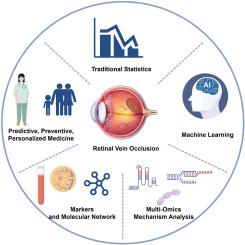视网膜静脉闭塞的多模态数据驱动方法:整合机器学习和生物信息学的叙述综述
IF 3.4
Advances in ophthalmology practice and research
Pub Date : 2025-07-14
DOI:10.1016/j.aopr.2025.07.002
引用次数: 0
摘要
背景视网膜静脉阻塞(RVO)是全球范围内视力损害的主要原因。其病理机制涉及血管阻塞、缺血和继发性炎症反应的复杂相互作用。最近跨学科的进展,在多模式数据整合的基础上,为揭示RVO的病理生理机制建立了一个新的范式,使早期诊断和个性化治疗策略成为可能。这篇综述批判性地综合了机器学习、生物信息学和临床医学交叉领域的最新进展,重点是建立预测模型和深入分析,探索分子机制,以及识别与RVO相关的标志物。通过将技术创新与临床需求相结合,本综述强调了数据驱动策略在推进RVO研究和优化患者护理方面的潜力。机器学习与生物信息学的结合通过预测建模和机制洞察,特别是通过深度学习增强的视网膜成像和多组学网络,彻底改变了RVO研究。尽管取得了进展,但临床翻译需要解决数据标准化不一致和模型通用性限制。通过跨学科合作,建立多中心验证框架和可解释的人工智能工具,再加上以患者为中心的数据平台,可以实现精确干预,以最佳方式保护视力。本文章由计算机程序翻译,如有差异,请以英文原文为准。

Multimodal data-driven approaches in retinal vein occlusion: A narrative review integrating machine learning and bioinformatics
Background
Retinal vein occlusion (RVO) is a leading cause of visual impairment on a global scale. Its pathological mechanisms involve a complex interplay of vascular obstruction, ischemia, and secondary inflammatory responses. Recent interdisciplinary advances, underpinned by the integration of multimodal data, have established a new paradigm for unraveling the pathophysiological mechanisms of RVO, enabling early diagnosis and personalized treatment strategies.
Main text
This review critically synthesizes recent progress at the intersection of machine learning, bioinformatics, and clinical medicine, focusing on developing predictive models and deep analysis, exploring molecular mechanisms, and identifying markers associated with RVO. By bridging technological innovation with clinical needs, this review underscores the potential of data-driven strategies to advance RVO research and optimize patient care.
Conclusions
Machine learning-bioinformatics integration has revolutionised RVO research through predictive modelling and mechanistic insights, particularly via deep learning-enhanced retinal imaging and multi-omics networks. Despite progress, clinical translation requires resolving data standardisation inconsistencies and model generalizability limitations. Establishing multicentre validation frameworks and interpretable AI tools, coupled with patient-focused data platforms through cross-disciplinary collaboration, could enable precision interventions to optimally preserve vision.
求助全文
通过发布文献求助,成功后即可免费获取论文全文。
去求助
来源期刊

Advances in ophthalmology practice and research
Ophthalmology
CiteScore
1.70
自引率
0.00%
发文量
0
审稿时长
66 days
 求助内容:
求助内容: 应助结果提醒方式:
应助结果提醒方式:


